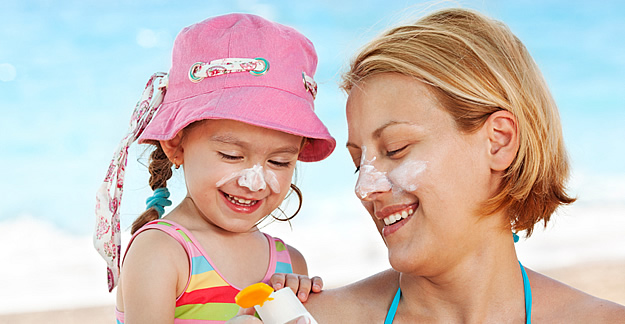There’s no doubt that you should be lotioning up: Almost 9,500 people in the United States are diagnosed with skin cancer every day, according to the American Academy of Dermatology. What’s more, the rate of new melanoma cases among American adults has tripled since the 1970s, from 7.9 in 100,000 people to 22.6 in 100,000 people, according to the National Cancer Institute.
Equally important as wearing sunscreen, is knowing what’s in your sunscreen. There are sunscreen ingredients, both active and inactive, that may be harmful to you. Here are three ingredients that you should avoid, plus three must-have ingredients that make for a safe and effective sunscreen.
Browse This Article
Avoid These 3 Sunscreen Ingredients
Hormone Disruptors
Read the label and look out for the sunscreen ingredients oxybenzone, octinoxate, avobenzone, and ecamsule. These are common sunscreen ingredients with unknown toxicity concerns. An FDA study shows that these ingredients are absorbed into the bloodstream, through your skin, in high enough levels that the FDA is setting new requirements for manufacturers to study them further.
Other studies indicate that these chemicals have been linked to disruption of sperm function in men and estrogen in women. Oxybenzone (UV filter) and octocrylene (an emulsifier) are two of those ingredients.
Instead of standard sunscreen, opt for what is called physical sunscreen. These specific lotions contain minerals such as titanium dioxide or zinc dioxide and sit on your skin to deflect harmful rays. Compared to other sunscreens, you can apply these once you’re outside.
If all you have access to is a sunscreen with the ingredients above, put it on anyway. The FDA and most dermatologists assert that the risk of severe sun exposure is greater than the risk of absorbing these chemicals.
Retinoids
Retinyl palmitate is a form of Vitamin A that is often used in skin care products for its purported ability to slow skin aging. However, more recent studies, although inconclusive, show that that retinyl palmitate may break down in the sun and become carcinogenic and even speed up the development of skin lesions and tumors.
“I like it for anti-aging; I don’t like it in the sun,” says Debra Jaliman, MD, an assistant clinical professor of Dermatology at Mount Sinai School of Medicine in New York. “It thins your skin, so it can make the sun penetrate more, and there’s research that it’s not so good in sunlight.”
Sprays
First and foremost, sprayable sunscreens aren’t FDA-approved. With that in mind, the FDA also says that you should avoid spraying it on your face and mouth as to avoid inhaling it, that spray-on sunscreen is flammable, and that you need to rub it in with your hands after it touches your skin.
The main selling point of a spray is that it’s more convenient than its lotion counterpart, but with all of the above info in mind, is it? Of course, if a sprayable sunscreen is the type of sunscreen that you’ll use — then it’s the right kind.
3 Must-Have Sunscreen Ingredients
Broad Spectrum Protection
Most dermatologists agree that sunscreens should contain protection from both UVA and UVB rays.
“UVB leads to burning of the skin, but UVA penetrates even deeper into the skin and is linked to aging and skin cancer,” says Roopal Kundu, MD, associate professor in dermatology and medical education at the Feinberg School of Medicine at Northwestern University in Chicago.
Not long ago, sunscreens only protected against UVB so people would tan, not burn. This led to a false sense of security, says Diane S. Berson, MD, associate professor of dermatology at Weill Medical College of Cornell University. “In reality, they were getting more UVA, which contributes to the development of skin cancer.”
Sun Protection Factor (SPF) of at Least 30
Although the FDA suggests a minimum of 15 SPF, the American Academy of Dermatology recommends no less than 30 SPF, which blocks 97% of the sun’s rays — that’s 30 times the protection than if you’d gone out with none at all. While higher SPF might add a bit more, nothing is 100%, warns Dr. Kundu.
Also, sunscreen should be reapplied every two hours to be effective.
Water Resistance
You’re not going to see label claims that were once prominent, like “waterproof” or “sweatproof.” The FDA banned the use of those terms under regulations issued in 2011. Instead, manufacturers use the term water-resistant to describe a sunscreen’s ability to maintain its effectiveness.
If you’re going to swim or be active outside, then choose a water-resistant sunscreen and plan to reapply every 40-80 minutes.
Compliance is Key
“If a person is irritated by what they’re using or it feels greasy or heavy, then they’re not going to use it,” says Dr. Berson. “I want it to be efficacious and also cosmetically acceptable, so they use it.”
According to Steven Q. Wang, MD, director of dermatological surgery and dermatology at Memorial Sloan Kettering Cancer Center in Basking Ridge, NJ, people should avoid the sun and wear hats and protective clothing — sunscreen is the last line of defense.







